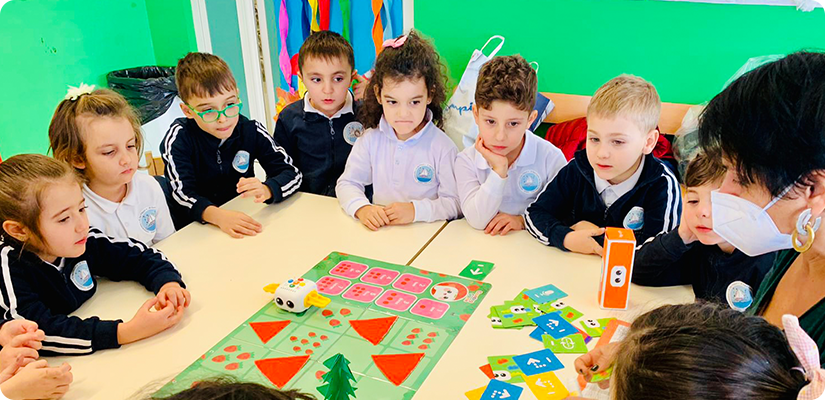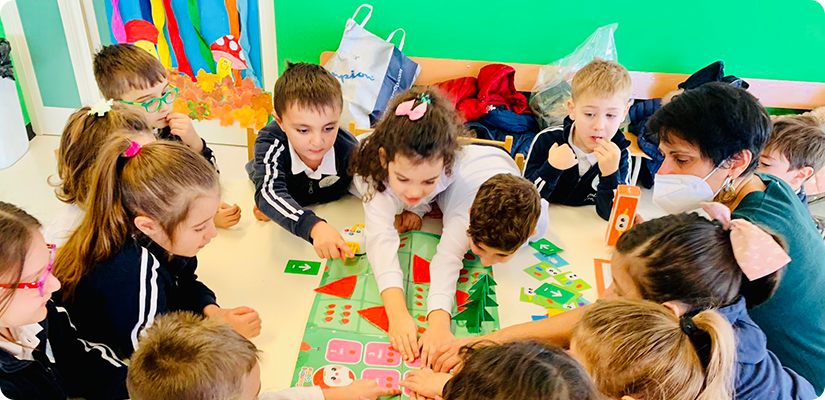
How many kids are in a group
15
How was the MatataStudio robot(s) used?
FROM STORYTELLING TO RESPECT FOR THE ENVIRONMENT AND RECYCLING From reading the book “Like a tree”, we develop the idea of environmental education for the survival of ourselves. We learn to understand that: trees are living beings; man is a living being just like a tree; the tree has behaviors similar to human beings; and they are essential for the life of the human being; we can get help from TALE BOT PRO to learn to respect trees: WE BUILD A TREE with recycled material: first we EXPLORE THE GARDENS that surround us and the WOODS of our Parco dei Monti Lattari The NATURAL ENVIRONMENTS THAT SURROUND US, can be reproduced with recycled material present in our section: the FOREST AND OUR COUNTRY, (sheets and pieces of cardboard that we no longer use, newspaper sheets, empty medicine boxes: we recycle the paper that is produced with tree trunks, WE DO NOT WASTE PAPER!). The trees (firs) have a shape: we learn to distinguish the flat geometric figures (the triangle); WE PROGRAM Tale Bot Pro using the elementary instructions and the microphone card, to collect the triangles scattered randomly on the thematic map of the NUMBERS, let’s count them in Italian and in English, WE RECORD our voice to make TALE BOT speak and let’s build a fir tree with the triangles made to draw this Bot and then cut out by us children.
What skills did it develop?
Learning outcomes: It starts the autonomous use of the first basic concepts of instrumental literacy of coding: elementary education, repetition, procedure, bug, debugging; Learn how to use Tale Bot Pro to draw; Develop eye-hand skills; Discriminates the flat geometric figures of the square and the triangle as “half” of the square. Use the ELEMENTARY INSTRUCTIONS and microphone cards to sort numbers and quantities, counting progressively and regressively up to 5; compare quantities and numbers up to 5; it makes associations between numbers and quantities; it uses the topological concepts (“bigger” and “smaller”, “closer” and “farther”), to search for simple shapes placed on a thematic map and create a simple sequence of instructions for the reconstruction of a path. Learn how to use the programming cards and the microphone card, to retrace different paths.

What worked best and what was challenging?
ADVANTAGES: Tale Bot Pro was an excellent mediator to keep the children’s attention on the didactic activity which they experienced as a “game”. These 4 and 5 year old children, in two hours, easily learned the proposed didactic contents, without ever taking their eyes off the activity or moving away from the group. This Bot manages to leverage the interests of children, at least initially focusing on their motivations: the spark of interest in their eyes has allowed us teachers to have relaxed and fun times to devote to the learning process. The interest is then fueled by the wonder when they understand the use of the microphone. For section teachers, thematic maps are particularly usable in section and very suitable for educational content: this has stimulated the purchase request. DISADVANTAGES: paper programming cards do not have that indentation that allows them to intuitively understand that the instructions must be linked; that same indentation that allows them to understand that the instructions are hooked like the pieces of a puzzle for the passage of information (input / output.

How did students respond?
This Bot manages to leverage the interests of children, at least initially focusing on their motivations: the spark of interest in their eyes has allowed us teachers to have relaxed and fun times to devote to the learning process. The interest is then fueled by the wonder when they understand the use of the microphone.

What is the favorite function for the students?
The recording function. the drawing function. the Interactive Maps. Storytelling (from the book, to the story, to the implementation of thematic maps) to build.


 日本語
日本語

